
current / archive / issues / faq / RSS feed / twitter /
The End Of The Beginning
| < previous | next > |
In my PhD thesis (which is the driving force behind this very blog) I go into quite a lot of detail about why this changeover matters. The general idea is that it marks a shift between what I call the "creation" phase of The Marvel Age, during which most of what we understand as "Marvel comics" is created by a small group of, largely, middle-aged men, to a "chaos" phase during which a new generation of, for the most part, much younger men take over. Its a changing of viewpoint too, from a group who learned their trade during the so-called Golden Age of comics, to a very different group who emerged from comics fandom, who take the very idea of superhero comics a lot more seriously.
That's the theory anyway - whether it actually has any effect on the comics is something we'll find out over the next several months. In the meantime though I think it's worth pausing to look at where we are so far. The blog began just over a year ago with a look at Doctor Doom's first appearance as baddy-of-the-month, but he very quickly developed into something much more, with the key change being his origin story in Fantastic Four Annual #2, which saw him develop as more of an anti-hero, with his own complex motivations and, usually, the sympathy of the audience.
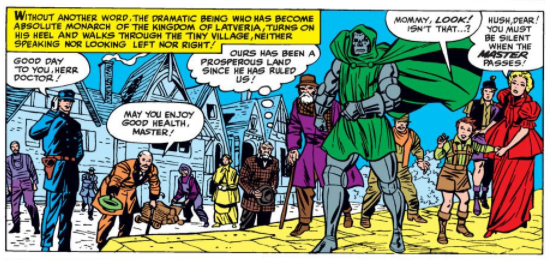 The key signifiers of Doom's history and appearance were pretty much set in stone then, to the extent that he could be used almost exclusively in 'Not Brand Echh' as a figure of fun, before returning to the main Marvel universe with his reputation and character intact.
The key signifiers of Doom's history and appearance were pretty much set in stone then, to the extent that he could be used almost exclusively in 'Not Brand Echh' as a figure of fun, before returning to the main Marvel universe with his reputation and character intact.
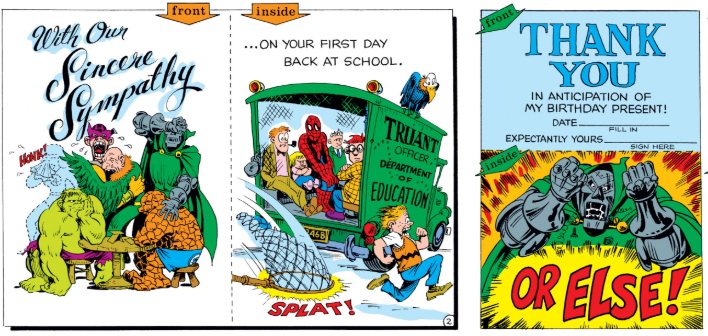 Doom's appearance and origin were so set in stone that they've remained more or less the same until the present day, but his character continued to develop. Stan Lee gradually steered him towards becoming a semi-satire on East European dictators, becoming more outright villainous, and more ready to believe his own publicity.
Doom's appearance and origin were so set in stone that they've remained more or less the same until the present day, but his character continued to develop. Stan Lee gradually steered him towards becoming a semi-satire on East European dictators, becoming more outright villainous, and more ready to believe his own publicity.
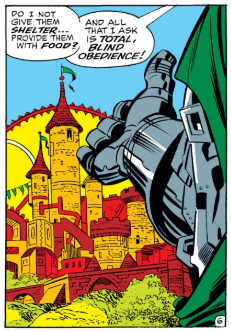 However, whenother writers such as Roy Thomas and Gerry Conway started to use Doom they moved him back towards the tragic anti-hero, acting with his own idea of honour and doing what he believed had to be done to the good of all (which admittedly tended to involve him ruling the world). These two versions of the character existed side by side for some time, with Stan Lee's version becoming more evil while others brought in characters like Valeria and Igor to shed light on his personality.
However, whenother writers such as Roy Thomas and Gerry Conway started to use Doom they moved him back towards the tragic anti-hero, acting with his own idea of honour and doing what he believed had to be done to the good of all (which admittedly tended to involve him ruling the world). These two versions of the character existed side by side for some time, with Stan Lee's version becoming more evil while others brought in characters like Valeria and Igor to shed light on his personality.
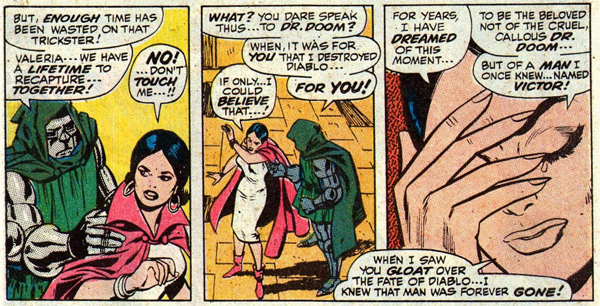 Archie Goodwin seemed to recognise this during Doom's final appearance in The Fantastic Four during this period, having Sue Richards accuse Doom of forgetting his honourable roots.
Archie Goodwin seemed to recognise this during Doom's final appearance in The Fantastic Four during this period, having Sue Richards accuse Doom of forgetting his honourable roots.
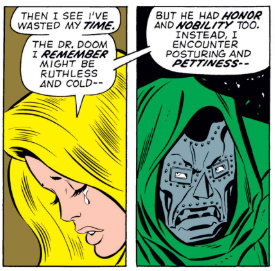 And of course, throughout this time Doom ventured out into other media, appearing wherever the Fantastic Four did and in other places beside. It seems that he was such a well-defined, portable character that he was the first choice for use as a villain not just in comics but elsewhere too.
And of course, throughout this time Doom ventured out into other media, appearing wherever the Fantastic Four did and in other places beside. It seems that he was such a well-defined, portable character that he was the first choice for use as a villain not just in comics but elsewhere too.
The next six years will see Doom travel even further across the Marvel Universe, appearing in most of their regular titles as well as on albums, radio, television, and even meeting the band Kiss. I'm really looking forward to seeing what happens, and hope you'll be along for the ride with me!
posted 29/1/2019 by Mark Hibbett
| < previous | next > |
Comments: